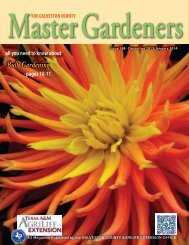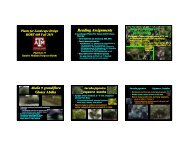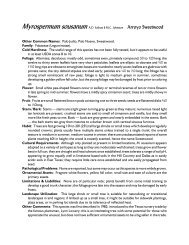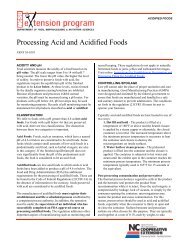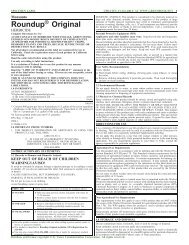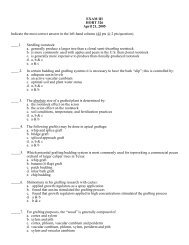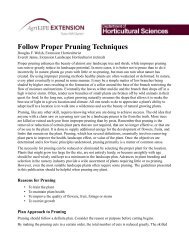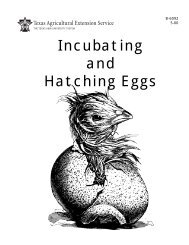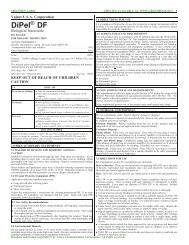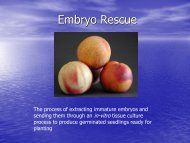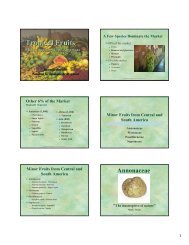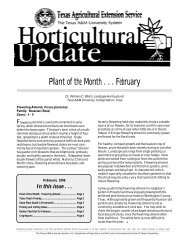Guide to PAS 2050 How to assess the carbon ... - Aggie Horticulture
Guide to PAS 2050 How to assess the carbon ... - Aggie Horticulture
Guide to PAS 2050 How to assess the carbon ... - Aggie Horticulture
Create successful ePaper yourself
Turn your PDF publications into a flip-book with our unique Google optimized e-Paper software.
32<br />
Section II: Calculating product <strong>carbon</strong> footprints<br />
of <strong>the</strong> product within each country over <strong>the</strong> chosen<br />
time period, unless more specific data is available. For<br />
more information, see <strong>PAS</strong> <strong>2050</strong> Section 6.4.6.<br />
Allocation<br />
Allocation of emissions is required where a process<br />
contributing <strong>to</strong> a given product’s life cycle results in<br />
more than one useful product, i.e. a co-product, or<br />
by-product o<strong>the</strong>r than waste. Unlike waste, co-products<br />
have economic value and can be sold – as such <strong>the</strong>y<br />
represent o<strong>the</strong>r discrete products.<br />
‘Allocation’ involves <strong>the</strong> partitioning of GHG<br />
emissions from a single process <strong>to</strong> <strong>the</strong> different<br />
outputs of that process.<br />
<strong>PAS</strong> <strong>2050</strong> specifies <strong>the</strong> following approach <strong>to</strong> allocation.<br />
First, break down <strong>the</strong> process in<strong>to</strong> sub-processes that<br />
each have only one output.<br />
Exclusions<br />
The following emission sources are excluded from <strong>the</strong><br />
<strong>PAS</strong> <strong>2050</strong> life cycle GHG emission <strong>assess</strong>ment.<br />
1. Capital goods<br />
These emissions are excluded based on:<br />
• lack of <strong>carbon</strong> footprint data currently available<br />
<strong>to</strong> identify sec<strong>to</strong>rs where capital goods emissions<br />
are material and<br />
• cost/complexity of analysis<br />
‘Capital goods’ are <strong>the</strong> goods used in <strong>the</strong> life<br />
cycle of a product, such as machinery, equipment<br />
and buildings.<br />
2. Aircraft emissions uplift fac<strong>to</strong>r<br />
This is excluded due <strong>to</strong> considerable uncertainty on<br />
<strong>the</strong> relative size of <strong>the</strong> impact of non-CO 2<br />
emissions<br />
from aviation through radiative forcing<br />
3. Offsets<br />
These are excluded because <strong>PAS</strong> <strong>2050</strong> is an<br />
<strong>assess</strong>ment of a specific product’s life cycle GHG<br />
emissions; any reductions <strong>to</strong> <strong>the</strong> footprint should<br />
be directly attributable <strong>to</strong> changes made <strong>to</strong> <strong>the</strong><br />
product’s life cycle, not through unrelated activities<br />
such as purchase of emissions credits.<br />
If this cannot be done, <strong>the</strong>n expand <strong>the</strong> system <strong>to</strong> include<br />
impact of displaced products (e.g. avoided electricity<br />
due <strong>to</strong> a process relating <strong>to</strong> <strong>the</strong> product also<br />
generated electricity)<br />
When nei<strong>the</strong>r of <strong>the</strong>se avoidance measures is possible<br />
or practical, allocate GHG emissions in proportion <strong>to</strong><br />
<strong>the</strong> economic value of <strong>the</strong> co-products (economic<br />
allocation), unless o<strong>the</strong>rwise stated in <strong>PAS</strong> <strong>2050</strong>.<br />
In our croissants example, flour milling produces two<br />
co-products in addition <strong>to</strong> flour (<strong>the</strong> relevant product<br />
input): animal feed and wheat germ. For <strong>the</strong> purposes<br />
of this example, assume <strong>the</strong> milling process cannot be<br />
broken down in<strong>to</strong> sub-processes resulting in discrete<br />
outputs, nor can system expansion be applied because<br />
no single displaced/avoided product can be identified<br />
for ei<strong>the</strong>r of <strong>the</strong> two co-products.<br />
In this case, economic allocation would be used: <strong>the</strong><br />
GHG emissions arising from flour production – and<br />
<strong>the</strong> associated inputs – would be shared across <strong>the</strong>se<br />
products according <strong>to</strong> revenue (as shown in Table 3).<br />
Thus, in this example, <strong>the</strong> GHG emissions arising<br />
from flour production would be allocated <strong>to</strong> <strong>the</strong> three<br />
products according <strong>to</strong> revenue:<br />
• 78% <strong>to</strong> flour<br />
• 20% <strong>to</strong> wheat germ<br />
• 2% <strong>to</strong> animal feed



